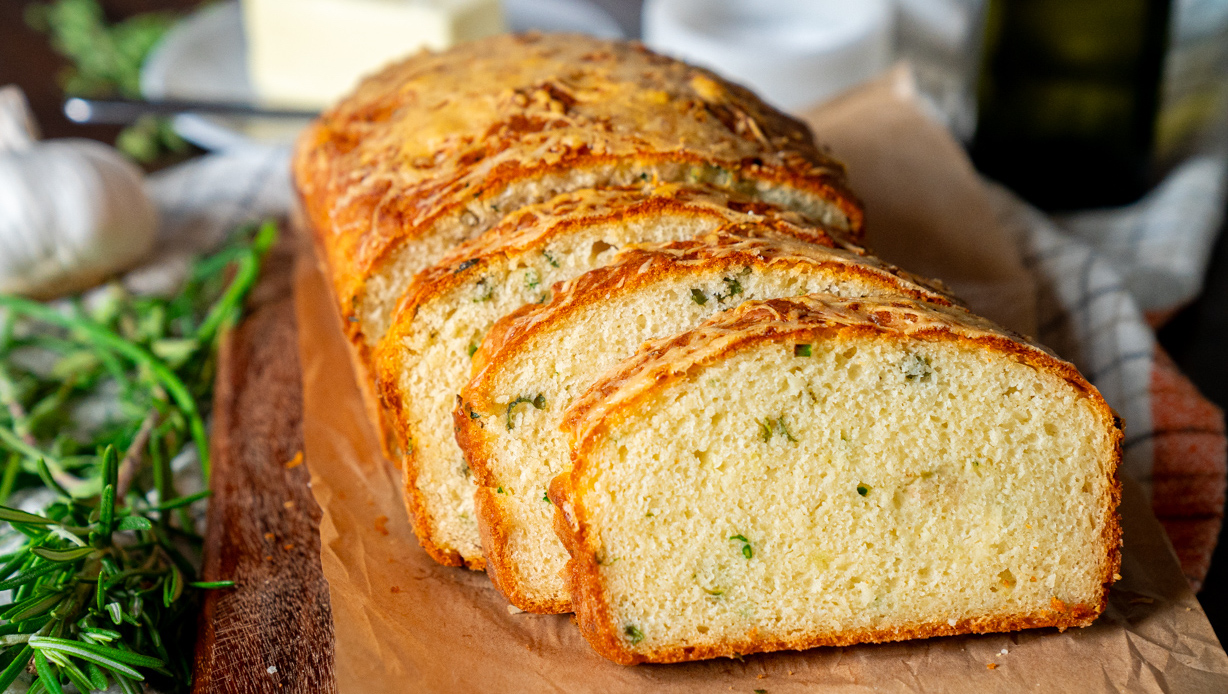 Pin it
Pin it
This homemade herb and cheese bread transforms everyday ingredients into a rustic loaf that pairs perfectly with soups and stews. The buttermilk creates a tender crumb while fresh herbs and parmesan add incredible aroma and flavor that store-bought bread simply cannot match.
I first made this bread during a dinner party emergency when I realized I had forgotten to buy bread for the Italian soup I was serving. My guests ended up ignoring the soup and fighting over the last slice of this bread instead.
Ingredients
- All purpose flour: forms the foundation of this bread giving it structure and a tender crumb
- Baking soda and baking powder: work together as leavening agents to create the perfect rise without yeast
- Granulated sugar: balances the savory elements and helps with browning
- Salt: enhances all the flavors and is essential for proper bread flavor
- Buttermilk: provides tanginess and activates the leavening agents for a perfect rise
- Large egg: adds richness and helps bind the ingredients
- Fresh garlic cloves: add wonderful aromatic flavor that permeates the entire loaf
- Olive oil: creates moisture and a tender texture throughout the bread
- Fresh herbs (oregano, chives, thyme, and rosemary): provide bright seasonal flavor
- Parmesan cheese: creates an irresistible golden crust with salty umami notes
Step-by-Step Instructions
- Prepare Your Equipment:
- Preheat your oven to exactly 350 degrees F and thoroughly grease every inch of your 9x5 inch bread pan making sure to get into the corners. A well-greased pan ensures your bread will release perfectly after baking.
- Mix Dry Ingredients:
- Sift the flour, baking soda, baking powder, sugar, and salt together in a large bowl. Sifting incorporates air and removes any lumps creating a lighter textured bread.
- Combine Wet Ingredients:
- In a separate bowl, whisk together buttermilk, egg, and minced garlic until completely smooth. The egg should be fully incorporated with no streaks remaining.
- Create Your Batter:
- Slowly pour the wet ingredients into the dry ingredients, folding gently with a spatula until just combined. Overmixing will develop too much gluten resulting in a tough bread. Add the olive oil and fresh herbs with just a few more folds until evenly distributed throughout the batter.
- Prepare For Baking:
- Transfer your batter to the prepared bread pan using a spatula to smooth the top. Drizzle the additional tablespoon of olive oil evenly across the surface then sprinkle the parmesan cheese in an even layer.
- Bake To Perfection:
- Bake for 42 to 45 minutes until the top is a beautiful golden brown and a toothpick inserted into the center comes out clean. The internal temperature should reach 200°F if you have a thermometer.
- Cool And Serve:
- Allow the bread to cool in the pan for 25 minutes. This resting period is crucial as the bread continues cooking and sets its structure. Transfer to a wire rack before slicing to prevent the bottom from becoming soggy.
The rosemary in this recipe takes me back to my grandmother's garden where she grew herbs year round. She taught me that fresh herbs make all the difference in baking and would always run her fingers through the rosemary to release its oils before chopping. That extra step makes the aroma in this bread absolutely intoxicating.
Storing Your Bread
This quick bread stays fresh at room temperature for up to two days when wrapped tightly in plastic wrap or stored in an airtight container. For longer storage slice the completely cooled bread, place parchment paper between slices, and freeze in a freezer bag for up to three months. Reheat frozen slices directly in the toaster for a quick treat that tastes freshly baked.
Customizing Your Loaf
While this herb combination creates a classic flavor profile, the recipe welcomes adaptation based on what you have available. Try substituting basil and oregano for an Italian twist or dill and parsley for a bright springtime variation. You can also experiment with cheese varieties replacing parmesan with sharp cheddar, gruyere, or even crumbled feta for different flavor profiles.
Serving Suggestions
This versatile bread shines as an accompaniment to hearty soups and stews but also makes an excellent base for sandwiches when sliced. For an elevated appetizer, slice the bread, toast it lightly, and serve with a compound butter made with additional fresh herbs. It also makes wonderful croutons when cubed and toasted in the oven with a drizzle of olive oil.
Frequently Asked Questions
- → What makes this bread so moist and flavorful?
The combination of buttermilk, olive oil, and fresh herbs makes the bread incredibly moist and packed with flavor. Garlic and parmesan further enhance its rich, savory taste.
- → Can I use dried herbs instead of fresh?
Yes, you can substitute fresh herbs with dried ones. Use about one-third the amount of dried herbs since they tend to be more concentrated in flavor.
- → How should I store the bread?
Wrap the bread tightly in plastic wrap or store it in an airtight container at room temperature for up to 2 days. For longer storage, freeze it for up to a month.
- → What can I serve with this bread?
This bread pairs wonderfully with soups, stews, salads, or as a side to roasted vegetables. It can also be enjoyed on its own as a snack or appetizer.
- → Can I make this bread gluten-free?
Yes, substitute the all-purpose flour with a gluten-free baking mix designed for quick breads. Check your other ingredients to ensure they are gluten-free as well.
- → What type of parmesan cheese works best?
Use freshly shredded parmesan cheese for the best flavor and texture. Avoid pre-grated versions, as they might not melt as evenly.
